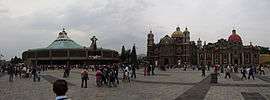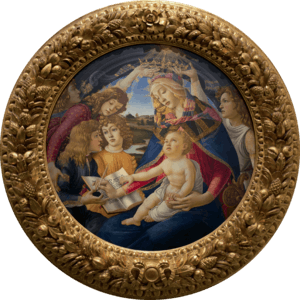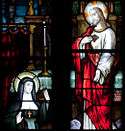Basilica of Our Lady of Guadalupe
| Basilica of Our Lady of Guadalupe | |
|---|---|
| Basílica de Nuestra Señora de Guadalupe | |
|
View of the new and the old basilica from the Plaza de las Americas | |
| Basic information | |
| Location | Villa de Guadalupe, Mexico City, Mexico |
| Geographic coordinates | 19°29′2.4″N 99°7′1.2″W / 19.484000°N 99.117000°WCoordinates: 19°29′2.4″N 99°7′1.2″W / 19.484000°N 99.117000°W |
| Affiliation | Catholic (Roman Rite) |
| District | Roman Catholic Archdiocese of Mexico |
| Year consecrated | 12 October 1976 |
| Ecclesiastical or organizational status | Minor basilica, National Shrine |
| Leadership | Monsignor Enrique Glennie Graue [1] |
| Website | www.virgendeguadalupe.org.mx |
| Architectural description | |
| Architect(s) | José Luis Benlliure |
| Architectural type | Church |
| Groundbreaking | 1974 |
| Completed | 1976 |
| Specifications | |
| Capacity | 10,000 |
| Height (max) | 42 metres (138 ft) |
| Dome dia. (outer) | 100 metres (330 ft) |
The Basilica of Our Lady of Guadalupe (Spanish: Basílica de Nuestra Señora de Guadalupe) is a Roman Catholic church, basilica and National shrine of Mexico in the north of Mexico City. The shrine was built near the hill of Tepeyac where Our Lady of Guadalupe is believed to have appeared to Saint Juan Diego Cuauhtlatoatzin. This site is also known as La Villa de Guadalupe or, in a more popular sense, simply La Villa, as it has several churches and related buildings.
The new Basilica houses the original tilma (or cloak) of Juan Diego, which holds the image of Our Lady of Guadalupe. One of the most important pilgrimage sites of Catholicism, the basilica is visited by several million people every year, especially around 12 December, Our Lady of Guadalupe's Feast day.
History
A nearby chapel was built on the sacred site devoted to a temple for Tonantzin (Tanontsin), an important mother goddess, after the Spanish conquerors destroyed the temple.
Pilgrimages have been made to this shrine almost uninterrupted since 1531-32. In the latter year, a shrine had been constructed at the foot of Tepeyac Hill, which served the people for ninety years. It was adapted as part of the parochial sacristy of the new basilica. In 1622 a rich shrine was erected; a newer one, much richer, in 1709. Other structures of the eighteenth century connected with it are a parish church, a convent and church for Capuchin nuns, a well chapel, and a hill chapel. About 1750 the shrine got the title of collegiate, and a canonry and choir service were established. In 1754 it was aggregated to the Basilica of St. John Lateran. In 1904 it was designated as a basilica.
Old basilica

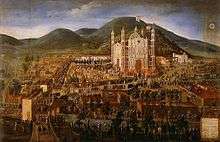
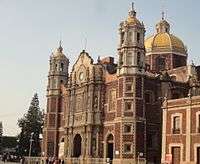
Officially known as the "Templo Expiatorio a Cristo Rey," the first structure of the old basilica was begun in 1695 and it was not finished until 1709. The major architect was Pedro de Arrieta. It is characterized by its doric interior and marble statues of Fray Juan de Zumárraga, archbishop at the time it was started, and Juan Diego, the peasant who saw the vision of the Virgin Mary. These are featured in the altarpiece that originally held the image of Our Lady of Guadalupe. (That altarpiece matches a similar one in the older chapel higher on the hill, which features the archangels Gabriel and Michael). The church was granted basilica status by Pope Pius X in 1904.
The icon of Juan Diego's cloak was housed in this church from 1709 to 1974. In 1921 a bomb planted in a flower vase near the altar by an anticlerical terrorist exploded, causing great damage to the interior of the building. (In memory of this incident, the New Basilica displays an iron crucifix called "the attempt on Christ".) The cloak survived undamaged.
As much of Mexico City was built on a former lake, the land was unstable and the old basilica was sinking. A new, more spacious basilica was built. The old one was closed for many years and repairs have recently finished. It is open to the public and perpetual adoration is held there. It is a very important place for Mexico City.
Modern basilica
The present church was constructed on the site of an earlier 16th-century church that was finished in 1709, the Old Basilica. When this basilica became dangerous due to the sinking of its foundations, a modern structure called the New Basilica was built next to it; the original image of the Virgin of Guadalupe is now housed in this New Basilica. Built between 1974 and 1976, the new Basilica has a circular floorplan so that the image of the Virgin can be seen from any point within the building. The circular structure is 100 meters (330 feet) in diameter, and can accommodate up to 10,000 people. The choir is located between the altar and the churchgoers to indicate that it, too, is part of the group of the faithful. To the sides are the chapels of the Santisimo and of Saint Joseph. It has 9 chapels on the upper floor. Under the main floor are the Basilica's crypts, with 15,000 niches and 10 chapels. Its seven front doors are an allusion to the seven gates of Celestial Jerusalem referred to by Christ. In the Sanctuary grounds where the new Basilica is located there are also many other buildings, including the original chapel on the exact site of the apparitions to Juan Diego (Capilla del Cerrito) and the Old Basilica consecrated in 1709, as well as other chapels where Masses and other sacraments of the Church are celebrated daily.
Gallery
-

Old Basilica
-

Pocito Chapel
-

Capuchin Nuns' Temple
-

Image of Our Lady of Guadalupe in the New Basilica
Notes
- ↑ Archdiocese of Mexico (2009), Vicaría de Guadalupe - Antecedentes Históricos (in Spanish), archived from the original on 2011-07-22
References
- This article incorporates text from a publication now in the public domain:
 Lee, George (1913). "Shrine of Guadalupe". In Herbermann, Charles. Catholic Encyclopedia. New York: Robert Appleton Company.
Lee, George (1913). "Shrine of Guadalupe". In Herbermann, Charles. Catholic Encyclopedia. New York: Robert Appleton Company.
External links
- (Spanish) Interactive tour of the Basilica campus
- (Spanish) Official website of the Basilica, Virgen de Guadalupe
See also
- Roman Catholic Marian churches
- Mexico City Metropolitan Cathedral
- The Basilica of Guadalupe in Monterrey, Nuevo Leon, Mexico
- Santa María de Guadalupe, a famous monastery in Spain
| Wikimedia Commons has media related to Shrine of Our Lady of Guadalupe in Tepeyac, Mexico City. |
